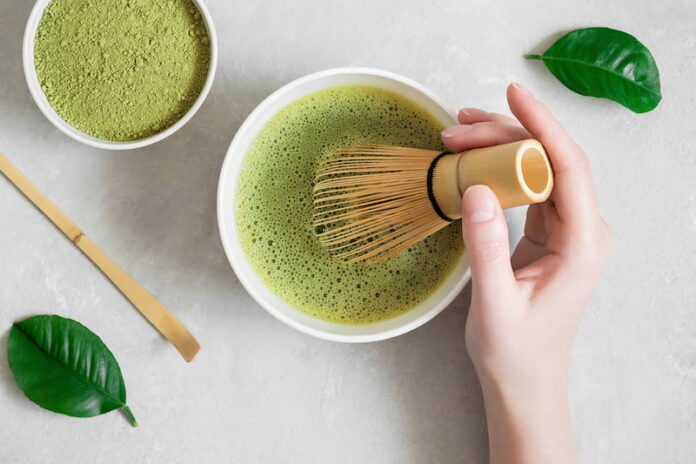Hey there! So, you’ve heard all the buzz about matcha – that vibrant green powder that’s not just pretty but packed with good stuff? It can seem a little fancy and intimidating at first, but trust me, making a delicious cup at home is simpler than you think. Forget complicated ceremonies for now; let’s just brew a great cuppa!
Step 1: Pick Your Perfect Matcha Powder
- Ceremonial Grade: Think of this as the “special occasion” matcha. It’s the top-shelf stuff, super smooth and delicate with a lovely sweetness. Perfect for sipping straight up. You’ll recognize it by its bright, happy green color.
- Culinary Grade: This is your “kitchen adventures” matcha. It’s bolder in flavor and fantastic for blending into lattes, smoothies, or baking. It’s usually a bit less expensive too.
- Pro Tip: Look for that bright green color! Dull or yellowish powder is probably old or not great quality. Finely ground powder dissolves way better, giving you that silky smooth texture.
Step 2: Gather Your Gear (No Fancy Kit Needed!)
Don’t stress if you don’t have traditional tools. Here’s what you really need:
- Matcha Powder: Obviously!
- A Small Bowl: A wide cereal bowl or small mixing bowl works perfectly. You just need room to whisk comfortably.
- A Whisk: The traditional bamboo one (called a chasen) is awesome and creates amazing froth. But honestly? A small regular kitchen whisk, a milk frother, or even a small fork will do the job! Don’t let the lack of a bamboo whisk stop you.
- A Sifter (Highly Recommended): Clumpy matcha is sad matcha. A tiny fine-mesh strainer helps avoid lumps for a smooth drink.
- Something to Scoop: A 1/4 teaspoon, a regular teaspoon (use roughly half), or even the end of a butter knife works. Aim for about 1-2 teaspoons per cup.
- Hot Water: Crucial! Boiling water makes matcha taste bitter and harsh. Let your kettle sit for a minute or two after boiling, or aim for about 175°F (80°C). Filtered water tastes best.
Step 3: Let’s Make Some Magic! (The Brewing Steps)
- Sift it: Put 1-2 teaspoons of matcha powder into your sifter over the bowl. Give it a gentle tap to break up any clumps. This step makes a huge difference!
- Add Water: Pour in about 2 ounces (1/4 cup / 60ml) of your hot (not boiling!) water.
- Whisk it Up! Grab your whisk. The key is a quick, zig-zag “W” or “M” motion right at the surface. Start gently to mix the powder, then whisk more vigorously until you get a nice layer of frothy bubbles on top (this is where the bamboo whisk shines, but any whisk works!). Aim for about 15-30 seconds. You want it smooth and foamy.
- Enjoy! That’s it! Sip it straight from the bowl for the authentic feel, or pour it into your favorite mug. Traditionally, it’s enjoyed without sweeteners to appreciate its unique grassy-sweet flavor, but hey, it’s your matcha!
Bonus Tips to Level Up Your Matcha Game
- Too Strong? Turn it into a latte! Heat and froth some milk (dairy or plant-based) and pour it over your whisked matcha. Creamy deliciousness!
- Want it Sweeter? A little honey, maple syrup, agave, or even a pinch of sugar balances the natural bitterness beautifully. Add it after whisking.
- Feeling Fancy? A drop of vanilla extract or a sprinkle of cinnamon can add a fun twist.
- Start Simple: If you’re new, begin with ceremonial grade. It’s smoother and less likely to be bitter.
- Mindful Moment: Matcha has a calming energy (thanks to L-theanine!). Savor it slowly as a peaceful morning ritual or an afternoon pick-me-up without the jitters.
- Go Easy: Matcha packs a punch! One serving a day is plenty, especially when you’re starting out.
- Experiment! Try different grades, brands, water temperatures, and whisking times. Find your perfect cup.
See? Brewing matcha is totally doable and kind of fun! Don’t worry about perfection on the first try. Just grab some powder, give it a whisk, and enjoy your vibrant green cup of goodness. Happy brewing!
Did you find this helpful? Check out our other helpful articles on our website.
Read Also
- Why the Keto Diet Works for Some People—and Fails Dramatically for Others: An Ayurvedic Breakdown for Modern HealthcareThe keto diet has dominated weight-loss culture for years. For some people, it produces rapid fat loss, stable energy, and improved mental clarity. For others—especially those who gain weight easily—it leads to burnout, digestive distress, rebound weight gain, high cholesterol, and a metabolism that feels slower than before. Healthcare often frames this as a discipline… Read more: Why the Keto Diet Works for Some People—and Fails Dramatically for Others: An Ayurvedic Breakdown for Modern Healthcare
- How to Choose the Best Assisted Living Facility for SeniorsAre you looking for the right assisted living facility for a senior loved one? Choosing a place can feel overwhelming. There are many factors to consider, from care services to the environment. Safety, comfort, and social opportunities play important roles in daily life. Each senior has unique needs and preferences that must be met. Understanding… Read more: How to Choose the Best Assisted Living Facility for Seniors
- Burn Smart, Not Hard; Shape Burn: Clean Protein for Weight ManagementYou want to feel light, strong, and confident. You don’t want crash diets or fake promises. You need a plan that works with your body, not against it. That’s where Shape Burn comes in. You can burn fat without losing strength. You can eat better and stay full. You can manage weight in a way… Read more: Burn Smart, Not Hard; Shape Burn: Clean Protein for Weight Management
- Creatine Basics: How Much Is 5g, How Much Water You Need, and Whether Pills or Powder Work BetterIf you’ve ever walked into a supplement aisle or scrolled through fitness TikTok, you’ve probably seen people talking about creatine — usually with a shaker bottle in hand and promises of better workouts and faster gains. And honestly? They’re not wrong. Creatine is one of the most researched and effective supplements for muscle strength, recovery,… Read more: Creatine Basics: How Much Is 5g, How Much Water You Need, and Whether Pills or Powder Work Better
- Understanding Breast Cancer in Men: Key Facts and SymptomsBreast cancer is often thought of as a disease that only affects women. However, men can develop it too. Although it is less common, early detection and awareness are important. Read on to learn key facts, symptoms, and ways men can take action to protect their health. How Common Is Breast Cancer in Men? Breast… Read more: Understanding Breast Cancer in Men: Key Facts and Symptoms
- Raising Awareness: Breast Cancer Facts for Older MenBreast cancer does not affect only women, and many older men do not realize they are at risk. Because the signs can be easy to miss, many men learn about the disease only when it has progressed. Learning the basic facts now can help you stay aware and respond early. If you want to protect… Read more: Raising Awareness: Breast Cancer Facts for Older Men
- How Regular Exercise Transforms Senior Living for the BetterGetting older is something everyone experiences, but how we age can be greatly influenced by the choices we make. One of the best ways for seniors to stay healthy, happy, and independent is through regular exercise. Staying active isn’t just about fitness-it can improve nearly every part of life. From building strength and energy to… Read more: How Regular Exercise Transforms Senior Living for the Better
- The Importance of Mammograms and Early Detection for Aging WomenAs women age, taking care of their health becomes even more important. One key part of women’s health is regular breast screenings. Mammograms are a simple but powerful tool that can detect breast changes early. Early detection can save lives by finding problems before they become serious. For aging women, staying informed and proactive about… Read more: The Importance of Mammograms and Early Detection for Aging Women









